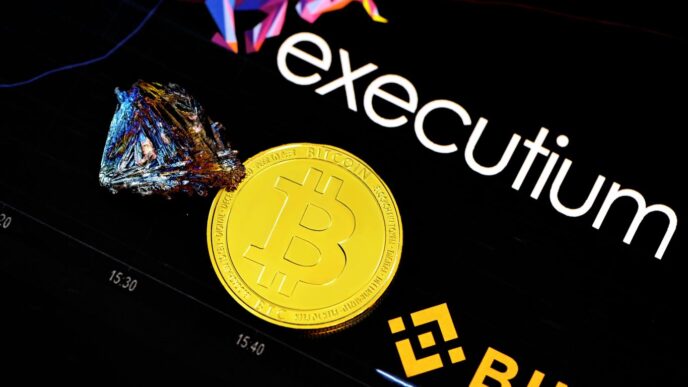Crypto markets have taken a beating in 2025, and a lot of people are asking: why is crypto crashing? It’s been a wild ride—prices shot up after last year’s ETF approvals, but now it feels like the brakes slammed on. Bitcoin and Ethereum dropped fast, liquidations piled up, and altcoins got hit even harder. Some folks blame big traders, others point to ETF outflows or shaky global news. Whatever the reason, everyone’s feeling the pressure and wondering what happens next. Let’s break down what’s really going on.
Key Takeaways
- The 2025 crypto crash came after a huge rally, with a sharp correction triggered by big liquidations and weak liquidity.
- Massive withdrawals from Bitcoin and Ethereum ETFs pulled support away, making prices fall even faster.
- A strong dollar, high interest rates, and unclear global regulations made investors even more nervous.
- Institutional investors, like pension funds and ETFs, played a bigger role in both the crash and the market’s possible recovery.
- Stablecoins also faced trouble, with some losing their pegs and shaking confidence in the whole crypto system.
Why Is Crypto Crashing: The 2025 Market Downturn Revealed
September 2025 turned into a wild ride for crypto fans, shaking the confidence of new and old traders alike. Bitcoin, fresh off highs close to $118,000, tumbled down past the $114,000 mark within weeks, and Ethereum had a rough drop below $4,100. It’s clear this wasn’t just a random blip—the market got swept up in what’s now called the “Autumn Algae Bloom.” To make sense of these events, let’s break down what happened, how it stacks up against previous crashes, and why the actions of big market players (the so-called “whales”) played such a big part.
The Autumn Algae Bloom: A Correction in Context
This year’s correction didn’t come out of nowhere. Altcoins, especially, started showing weakness way before the major crash. The entire crypto space lost over a trillion dollars in market cap as:
- Big holders dumped huge stacks of Bitcoin at thinly traded price levels…
- Traders with big, risky positions got wiped out by liquidations…
- ETFs saw outflows at the worst possible moment, pulling out cash that might have cushioned the fall.
Here’s a quick table with some numbers from September’s wipeout:
| Metric | Value |
|---|---|
| Bitcoin Price Drop | $118,000 → $114,000 |
| Ethereum’s Lowest Point | $4,075 |
| Total Liquidations (24 hrs) | $1.7B+ |
| Altcoin Loss (average, top 20) | -29% |
Despite these losses, seasoned traders know that corrections like this are a regular feature of any cryptocurrency market cycle.
Comparing 2025 to Past Crypto Cycles
If you’re old enough to remember Bitcoin’s brutal 84% fall back in 2018, or the FTX-triggered panic in 2022, this year feels a little less scary. Every crash tends to have its own story, but the cycle is familiar:
- A wild bull run—usually triggered by something like U.S. ETF approvals or halving events
- Market excitement peaks, then cracks form (this time, the predicted Bitcoin crash caught many off-guard)
- Old hands brace for a correction, and soon enough, the sell-off snowballs
What’s different in 2025? Institutional adoption is up. Millions are watching ETF flows, not just what the big whales are doing. There’s more structure, but also more ways for risk to build up in the background.
Market Liquidations and Whale Activity
Here’s where things get pretty intense. This crash started with a whale offloading about 24,000 BTC right when order books were thin. That kind of move is enough to completely blast through support. Once leverage traders started getting liquidated, it became a feedback loop:
- Forced liquidations triggered more forced sales
- Market depth vanished
- The panic spread to Ethereum and altcoins, creating a bigger ripple effect
By the end of it, over $1.65 billion in leveraged trades evaporated within a day. Altcoins performed even worse—losing as much as 29% and continuing to drag down the total crypto market cap, which dropped well below key levels.
Is it over? Maybe not this week. Patterns like these don’t reverse overnight, especially if whales and institutional players are still rebalancing. But after every big wipeout, the chance for some kind of bounce—or at least calmer, more rational markets—grows stronger.
Liquidity Crunches and ETF Outflows: Key Drivers Behind the Crash

The recent crypto crash in late 2025 wasn’t just a case of bad luck; it was a classic chain reaction made worse by thin trading, leveraged bets, and big players pulling cash. Let’s break down what really set off this mess, and how ETF withdrawals and skimpy liquidity fueled the fire.
Leveraged Liquidations in Thin Markets
Honestly, things got ugly because folks took on too much risk when there just wasn’t much money sloshing around. Here’s how it unraveled:
- A few massive dump trades by whales flooded the market, pushing prices down fast.
- That set off forced liquidations—basically, exchanges automatically selling off leveraged long bets to cover loans.
- Each liquidation made prices fall harder, which triggered even more liquidations. A true domino effect.
It helps to look at the numbers from that wild weekend:
| Asset | 24-Hour Liquidations | Notable Trigger Point |
|---|---|---|
| Bitcoin | $1.65 billion | Dropped under $114,000 |
| Ethereum | $400 million | Fell below $4,000 |
Thin liquidity—meaning very few buy and sell orders on the books—made everything more severe. Usually, markets can absorb a big trade, but in these conditions? There was just no cushion. This is why the slide happened so fast.
Impact of Bitcoin and Ethereum ETF Withdrawals
To make matters worse, this crash hit right when institutional investors were yanking money from crypto ETFs. Bitcoin and Ethereum ETFs saw serious outflows:
| ETF Type | Outflow (One Period) |
|---|---|
| Bitcoin | $253.4 million |
| Ethereum | $251.2 million |
These ETFs had acted as a stabilizer. When that money got pulled, there wasn’t much holding prices up. The pressure increased, and sellers panicked.
A few reasons for the ETF withdrawals:
- Some big funds hit stop-loss triggers—automatic sell orders when prices dip.
- Worries about rising interest rates made other investments seem safer.
- Regulatory noise in both the US and Europe spooked a lot of portfolio managers.
Altcoin Volatility and Market Structure
Altcoins had it even tougher.
When the major coins crash and liquidity dries up, altcoins—already riskier and less traded—see wild price swings. This time:
- Altcoin prices lagged or fell harder, with some dropping 20% or more overnight.
- Order books for many smaller tokens were nearly empty after the big sell-off.
- Price floors and support levels broke quickly, with little resistance from buyers.
Here’s what’s typical when liquidity crunches hit altcoins:
- Prices slip below psychological support (for example, $1 for meme coins).
- Volatility triples as automated trading bots scramble to adjust.
- Recovery takes much longer compared to Bitcoin or Ethereum, as buyers stay cautious.
To sum up: Extreme leverage, thin trading books, and the sudden ETF outflows together created the perfect storm for a crash. It wasn’t just one bad trade, but a whole ecosystem suddenly out of balance.
Macro Pressures and Regulatory Anxiety Amplify Crypto Weakness
The crypto sell-off in 2025 didn’t come out of nowhere. While price charts show a steep, fast fall, a lot was bubbling underneath. If you zoom out, the mix of old-school economic problems and new regulatory uncertainty was like adding fuel to a fire already burning from market issues.
Inflation, Rates, and a Strong Dollar
Here’s what really added weight to the crypto market crash:
- Persistent inflation disappointed investors who were hoping for relief by fall 2025. Every month with higher prices put pressure on the Federal Reserve to keep rates higher.
- Higher interest rates meant bonds and cash became more attractive, so folks pulled money out of risky assets like crypto.
- The US dollar, flexing with strength, made global investing in crypto more costly when converted from other currencies. That alone was enough to spook international investors.
Across the board, if you were watching policy decisions and the dollar index climb, the mood in crypto communities got tense. Each disappointing inflation report felt like another jab.
Global Policy Uncertainty and Regulatory Drag
Honestly, it’s no surprise that regulators flexing their muscles made so many traders nervous. Here’s where it really hurt:
- Investigations and lawsuits in the US and EU shut some exchanges or forced them to limit withdrawals.
- New tax proposals and reporting rules landed with little warning. That led to panic selling by some, who worried they’d get caught in the crosshairs.
- Every fresh headline about fraud or a regulator "reviewing" a project seemed to push prices lower.
Crypto depends a lot on clear rules—or at least, confidence that new ones won’t suddenly make things way harder. Without it, even small, routine corrections risk spiraling into crashes.
Investor Sentiment Turns Risk-Off
By September, plain fear took over. Here’s what most people saw and felt:
- Prices fell sharply, so even long-term holders started questioning their positions.
- Social media and trading forums exploded with bearish messages and stories of big losses.
- Many investors switched from altcoins and smaller tokens to cash or stablecoins, deepening sell pressure.
When everyone feels like the walls are closing in, it becomes a self-fulfilling prophecy. As more people hit the sell button, the panic just fed on itself.
In short, macro stress and regulatory unknowns together made September’s correction much worse. History shows that it’s rarely just one thing that sends crypto tumbling—it’s usually a perfect storm.
Institutional Adoption: A Stabilizing or Destabilizing Force?
The relationship between Wall Street and crypto has always been a bit complicated. By 2025, institutional adoption has exploded—401(k)s offer crypto, banks roll out blockchain funds, and pensions own slices of Bitcoin.
Some folks expected all this big money to make crypto stable and trustworthy, but the reality has been anything but simple. Here’s how institutional money shaped the crash, for better and for worse.
Role of Traditional Finance in the 2025 Downturn
Traditional finance didn’t just dip its toes in—huge players dove in fast as ETFs and regulated funds opened the floodgates.
- Institutions brought a ton of liquidity at first, but they also brought stricter risk controls.
- When major funds faced losses elsewhere (think stock downturns or rising rates), they yanked money out of crypto to meet margin calls.
- Redemptions and rebalancing led to sharp selloffs in both Bitcoin and Ethereum, especially as ETF withdrawal windows hit.
Crypto markets, used to retail-driven chaos, got caught off-guard by the scale and speed of these institutional exits. What looked like support one month flipped into a stampede out the next.
ETFs, Pension Funds, and Market Resilience
ETFs were supposed to make things boring—in a good way. Instead, they became a double-edged sword.
| Institution Type | Typical Allocation (%) | Withdrawal Trend Q3 2025 |
|---|---|---|
| Pension Funds | 2.5 | -0.7 |
| Hedge Funds | 7.1 | -2.9 |
| Retail Investors | 18.3 | -4.3 |
| ETFs | 23.9 | -6.1 |
- When redemptions hit, ETFs had to sell real coins, pushing prices lower fast.
- Pension and retirement funds, aiming for long-term growth, pulled back but didn’t dump entirely—helping put a floor under prices.
- Hedge funds and faster money traders bailed first, causing the worst of the volatility.
Strategic Reentries and Accumulation Trends
It wasn’t all panic selling—2025 saw careful, strategic reentry too. History says contrarians wake up fast after a dump.
- Big institutions waited for capitulation, then started quietly buying again, especially in Bitcoin and a few rock-solid altcoins.
- Dollar-cost averaging (DCA) became the name of the game for longer-term players. No crazy bets—just steady buying on bad days.
- Some pension plans and insurance companies increased exposure after the worst was over, hoping to snag long-term returns on the rebound.
Bottom line: Institutional investors created shocks when they bailed, but also support as they edged back in. Regular investors can watch these moves for clues about when confidence is creeping back. If 2025 showed anything, it’s that Wall Street still moves in herds—just bigger, faster herds than crypto’s ever seen.
The Unique Case of Stablecoins: Depeggings and Systemic Risks
Stablecoins are supposed to be the boring side of crypto—safely pegged to the dollar, no wild price swings, just a place to park funds. But 2025 proved that’s not always true. When a stablecoin loses its $1 peg, the effects can ripple through the entire market, raising questions about stability and trust. In recent years, high-profile failures have shown how even the most well-promoted stablecoins have hidden vulnerabilities.
Reviewing Major Stablecoin Failures
Stablecoin depeggings aren’t new. Each high-profile failure reveals its own set of weaknesses:
| Stablecoin | Year | Model | Peak Value Lost | Why It Collapsed |
|---|---|---|---|---|
| NuBits (NBT) | 2018 | Algorithmic | Tens of millions | Unsustainable model, weak demand |
| TerraUSD (UST) | 2022 | Algorithmic (with LUNA) | ~$50 billion | Bank-run dynamics, flawed design |
| USDC | 2023 | Fiat-backed | Billions (temporary) | Bank failure, trust crisis |
| YU (Yala) | 2025 | Bitcoin-backed | Over $119 million | Exploit, thin liquidity |
What stands out: both algorithmic and fiat-backed coins have been hit. Problems range from code vulnerabilities and thin liquidity to outside shocks like bank closures and coordinated attacks.
Market Impact of the YU and TerraUSD Collapses
The Yala YU stablecoin event in 2025 looked like a textbook warning. An attacker exploited the Yala protocol, minted millions of unauthorized YU tokens, and dumped them across blockchains. This sent the price tumbling below $1. The underlying Bitcoin reserves weren’t touched, but it didn’t matter—confidence evaporated fast, and with little on-chain liquidity, the YU token struggled to keep its peg. Trading and arbitrage froze up, leaving investors scrambling.
TerraUSD was even bigger. In 2022, its collapse didn’t just wipe out tens of billions—it created chaos across multiple DeFi systems. Anchor protocol, which paid unsustainable yields, drove adoption till it stopped working. Once large investors exited, a death spiral started. LUNA went hyperinflationary while UST holders lost almost everything. Smaller investors had little warning and got the worst of it.
Collateral Models and Investor Confidence
Stablecoins use a few main models to try to keep their pegs:
- Fully-backed: 1-to-1 with cash or government bonds, like USDC
- Crypto-collateralized: Over-collateralized using digital assets, e.g., DAI
- Algorithmic: Peg maintained by code and related tokens, like the former UST
But as we’ve seen, liquidity shortages, cross-chain transfers, and even trusted cash reserves can fail during market stress. Some ideas gaining popularity in 2025:
- Real-time proof-of-reserves using blockchain data
- Tighter controls on cross-chain minting and bridging
- Insurance mechanisms and backstop funds for sudden runs
In short, the more complicated or experimental the model, the more investors seem to worry. Every new depegging chips away at trust, and any trigger—whether an exploit or a panic—can spread losses across the whole market. Until transparency and strong collateral become the norm, stablecoins may remain an unpredictable piece of the crypto puzzle.
Are Altcoins Doomed? Divergent Patterns Under a Bearish Spotlight
The market vibe right now feels pretty rough for altcoins. Bitcoin isn’t exactly thriving, but altcoins? Some of them look like they’ve slipped off a cliff. If you’ve been staring at your portfolio and wondering if your favorite token is cooked for good, you’re not alone. These coins aren’t following Bitcoin’s direction as tightly as they once did, and that’s where things start to feel unpredictable.
Analyzing the Altcoin Market Cap Breakdown
So, what’s really happening with altcoins? One thing’s clear: their market cap is shrinking faster than Bitcoin’s. The below table throws some numbers at the problem, showing major losses since September:
| Segment | Market Cap (Sept 1st) | Market Cap (Oct 9th) | Change |
|---|---|---|---|
| Total Altcoins | $1.36 trillion | $1.02 trillion | -25% |
| Top 10 Altcoins | $920 billion | $700 billion | -23.9% |
| Meme Coins | $97 billion | $58 billion | -40.2% |
These drops aren’t just numbers—they reflect real sell pressure. A handful of big coins lost even more. Altcoin liquidity dried up faster than expected, leaving many holders locked in or forced to sell at a loss.
Bearish Technical Signals and Support Trends
The technical story isn’t giving much hope either. Chart watchers keep pointing at support levels breaking, then staying broken. That’s usually bad news. Here are a few things folks are noticing:
- Relative Strength Index (RSI) for lots of altcoins dropped below 40, signaling oversold territory.
- Moving averages keep slipping downward, making it harder for coins to recover lost ground.
- Volume on most exchanges is low—nobody’s excited to buy dips right now, just sell rallies.
Prospects for Recovery and Longer-Term Growth
Does this mean altcoins are done forever? Not likely, but it’s probably going to take a while before confidence returns. Based on previous cycles and what analysts are saying, here’s what could help altcoins bounce back:
- Stronger projects with real use cases will keep building, even if prices sag for months.
- Increased mainstream or institutional interest—if it comes back—could give certain sectors (think DeFi or gaming) a fresh leg up.
- Regulatory clarity might help, removing some of the fear that’s keeping big buyers away.
Right now, most altcoin investors need patience. Some projects will get washed out, but others may come back surprisingly strong when the next uptrend starts. If history tells us anything, it’s that the weakest hands and weakest coins get shaken out first—what’s left might be a lot more resilient than folks expect.
Is This the Start of a New Cycle? Lessons and Opportunities for Investors
Historical Precedents and Post-Crash Recoveries
Let’s be honest—crypto crashes never feel good in the moment, but they aren’t new. The biggest gains have often come after the hardest hits. For example, Bitcoin lost more than 80% of its value in 2018, then surged over 2,000% within three years. The FTX fiasco triggered a huge drop, but patient investors who stuck around watched the market recover and even move beyond its old highs.
| Crash Year | Max Drawdown | Recovery/Next High | Time to Recovery |
|---|---|---|---|
| 2018 | -84% | +2,065% (2021) | 3 years |
| 2022 FTX | -77% | New All-Time Highs | ~2 years |
| 2025 | ~-10% (so far) | Unknown | Still unfolding |
Each time, panic sellers missed out on what came next. Still, the past doesn’t promise the future, and 2025’s correction has its own twist, with bigger players and more rules shaping the bounce-back.
Contrarian Strategies: Buying Fear, Selling Greed
Most people run for the exit when prices drop, but contrarians see a dip as a discount. They:
- Dollar-Cost Average: Buy the same dollar amount of crypto at regular intervals, which means more coins when prices fall.
- Watch market flow: When institutional money starts coming back in—like with ETFs and pension funds—some traders take this as a sign the worst is over. You can track this by following smart money rotations through on-chain data and ETF flows.
- Hold through noise: Selloffs drum up "end of crypto" headlines every time, but actual long-term rebounds tend to reward stubborn patience, not panic.
Contrarian mindsets can be lonely—nobody likes buying when Twitter is a panic fest—but history sides with the brave more often than not.
Pruning Weak Projects and Uncovering Innovation
Bear markets aren’t just storms to wait out. They drive change. When easy money dries up, shaky projects get tossed aside, leaving the strongest ideas to stand out. Here’s what investors typically do:
- Review portfolios, cutting coins with poor fundamentals or teams that fell silent during the crash.
- Focus on coins with healthy cash flow, clear roadmaps, and visible developer activity.
- Keep an eye out for new trends, like cross-chain protocols or better privacy tools, which often bubble up when hype fades.
Experienced holders often say a crash is just a filter: “The good gets cheaper, and the bad disappears.” Those who stick with solid assets tend to enter the next round in a much better spot. Every cycle has seen unexpected winners emerge—being early means keeping your eyes open when everyone else is looking away.
Conclusion
So, after all the drama, what does this crypto crash really mean? Honestly, it’s not the first time we’ve seen wild swings, and it probably won’t be the last. The 2025 downturn shook up a lot of people, especially with all the forced liquidations and big money moving out of ETFs. But if you look back, these kinds of corrections have always been part of the crypto story. Sometimes it feels like the market is just testing everyone’s patience. Still, the bigger picture hasn’t changed much—institutions are sticking around, and the tech keeps moving forward. If you’re thinking about what comes next, it’s probably a good idea to stay calm, keep learning, and remember that volatility is just part of the deal. Whether you’re in it for the long haul or just watching from the sidelines, crypto’s next chapter is still being written.
Frequently Asked Questions
Why did the crypto market crash in 2025?
The crypto market crashed in 2025 because of a mix of big sell-offs by large investors, forced sales from people using borrowed money, and lots of money leaving crypto ETFs. On top of that, worries about the economy and new rules made people nervous, so many sold their coins quickly.
How is the 2025 crash different from past crypto crashes?
This crash is different because more big companies and funds are involved now. In the past, crashes were mostly caused by regular traders. Now, with things like Bitcoin ETFs and pension funds holding crypto, the market is bigger and reacts differently. Also, the crash was not as deep as some in the past, and the market is recovering faster.
What role did ETFs play in the downturn?
ETFs, or exchange-traded funds, let people and big investors buy crypto easily. In 2025, many investors pulled their money out of Bitcoin and Ethereum ETFs all at once. This made prices drop even more because there was less money supporting the market.
Are stablecoins safe after what happened in 2025?
Stablecoins are supposed to stay the same price as the dollar, but some lost their value in 2025. Problems with how they are backed and sudden large trades caused a few to break away from their dollar value. So, while many stablecoins are safe, some can still have trouble if the market is stressed.
Will altcoins recover from this crash?
Altcoins, or smaller crypto coins, were hit harder than Bitcoin. Some may not recover if they have weak projects behind them. But others with strong teams and real uses could bounce back when the market gets better. It will take time, and not every altcoin will survive.
Is now a good time to invest in crypto after the crash?
Many experts say that buying during a crash can be a good idea if you believe in crypto for the long run. Prices are lower, so there is a chance for bigger gains if the market goes up again. But there are still risks, so it’s important to do research and not invest more than you can afford to lose.












